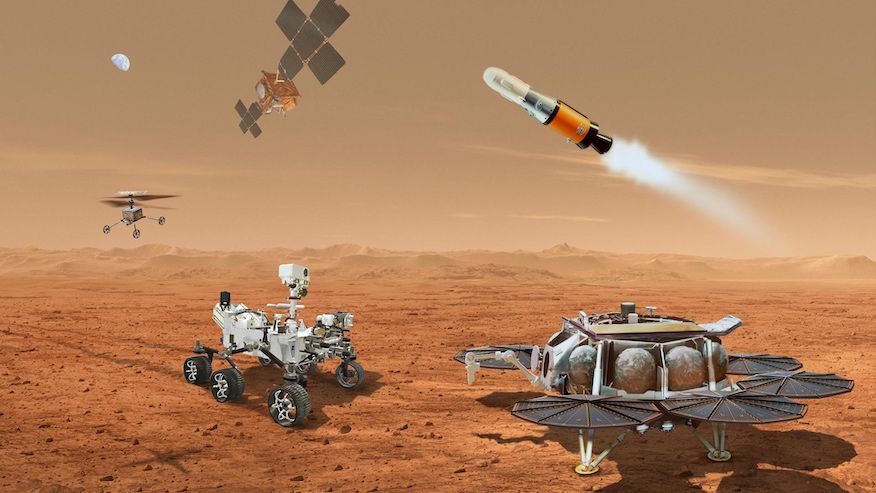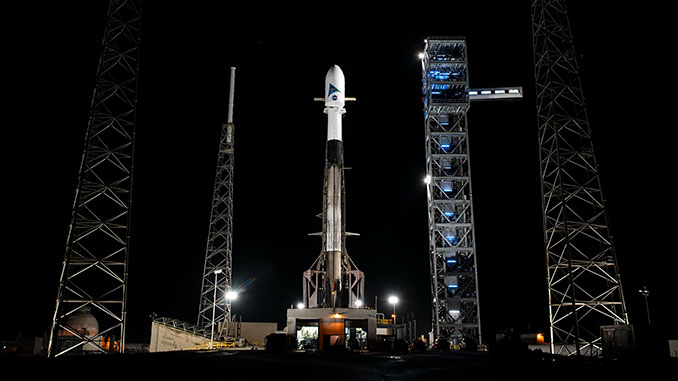Update: The Falcon 9 lifted off on time and successfully deployed the five BlueBird satellites.


A SpaceX Falcon 9 rocket is set to launch with the first five commercial satellites for AST SpaceMobile’s new cellular constellation. The satellites, called ‘BlueBird,’ are a precursor to the next generation of its satellites.
Liftoff from Space Launch Complex 40 (SLC-40) at Cape Canaveral Space Force Station is set for 4:52 a.m. EDT (0852 UTC), which is the opening of a four-hour window. However, weather may prove to be a spoiler for the launch opportunity.
Spaceflight Now will have live coverage beginning about one hour prior to liftoff.
Weather heading into the launch opportunity is far from ideal. The 45th Weather Squadron forecast just a 30 percent chance of favorable weather during the launch window.
“A stalled front stretching across the region and above normal atmospheric moisture will continue elevated chances of showers and thunderstorms across the Spaceport this week,” meteorologists wrote. “The front may be right overhead for the initial launch window early Thursday morning, and combined with a land breeze, the Probability of Violation will be on the higher end, with the Cumulus Clouds Rule, Thick Cloud Layers Rule and Surface Electric Fields Rule all possible.”
A 24-hour pivot would improve the weather up to a coin toss. One fortunate part of the mission for SpaceX is that the booster supporting the mission, tail number B1078, will be touching down at Landing Zone 1 (LZ-1) following stage separation. That means weather at a droneship site won’t be a potential roadblock to launch.
Prior to the BlueBird launch, B1078 flew 12 times, supporting a Crew Dragon mission to the International Space Station, the national security mission dubbed USSF-124, a pair of SES’ O3b mPOWER satellites and nine Starlink flights.
BlueBirds fly
The mission is the second launch for AST SpaceMobile, a company that describes itself as one which is “building the first and only global cellular broadband network in space to operate directly with standard, unmodified mobile devices based on our extensive IP and patent portfolio.”
It’s also a publicly traded company company on the NASDAQ under “ASTS.” It first launched on another SpaceX mission, when it sent up its BlueWalker-3 satellite.
Each of the five BlueBird satellites will include a communications array that extends to 693-square-feet “to establish connectivity directly with cell phones via 3GPP-standard frequencies, and in partnership with leading cellular service providers around the world.” The forthcoming first generation of Block 2 satellites will be 2,400-square-feet.

In early August, the company announced the reception of an initial license for space-based operations from the U.S. Federal Communications Commission (FCC). This allows AST SpaceMobile to “to launch and operate V, S and UHF frequencies to support gateway, feeder link and telemetry, tracking, and control operations for the first five commercial BlueBird satellites,” according to AST SpaceMobile.
“This regulatory milestone is a significant step to targeting 100% nationwide coverage from space of the continental United States on premium cellular spectrum,” said Scott Wisniewski, President of AST SpaceMobile, in a statement. “Through our strategic partnerships with companies like AT&T, Verizon, Vodafone and our other key partners around the world, we aim to enhance cellular connectivity globally, essentially eliminating dead zones and empowering remote areas with space-based cellular broadband connectivity.”
These first five, Block 1 satellites will allow AST SpaceMobile to begin beta testing of nationwide, non-continuous service through AT&T and Verizon. The mission has been delayed for years, in part due to supply chain issues, according to quarterly earnings reports.
Back in 2022, Space News reported that the initial five satellites would need to be “of similar size and weight” of the BlueWalker 3 prototype. According to its second quarter earnings summary, its about 95 percent through manufacturing and producing 17 Block 2 satellites at its manufacturing facilities in Tessas.



